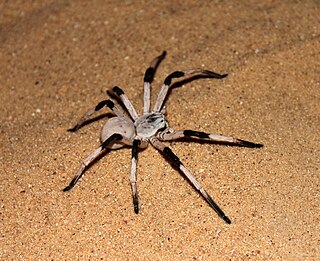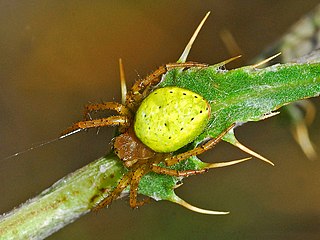
Ground spiders comprise Gnaphosidae, the seventh largest spider family with over 2,000 described species in over 100 genera distributed worldwide. There are 105 species known to central Europe, and common genera include Gnaphosa, Drassodes, Micaria, Cesonia, Zelotes and many others. They are closely related to Clubionidae. At present, no ground spiders are known to be seriously venomous to humans.

Selenopidae, also called wall crab spiders, wall spiders and flatties, is a family of araneomorph spiders first described by Eugène Simon in 1897. It contains over 280 species in nine genera, of which Selenops is the most well-known. This family is just one of several families whose English name includes the phrase "crab spider". These spiders are often called "Flatties" due to their flattened dorsal profile. The Afrikaans name for these spiders is "Muurspinnekop."

Alcimochthes is a genus of Asian crab spiders that was first described by Eugène Louis Simon in 1885. As of June 2020 it contains three species, found in eastern Asia: A. limbatus, A. melanophthalmus, and A. meridionalis.

Cerbalus aravaensis is a huntsman spider found in the southern Arava Valley of Israel and Jordan. The species was first described by Gershom Levy of the Hebrew University of Jerusalem in 2007, though news agencies later reported it in 2010 as a new discovery by a team of biologists from the University of Haifa. The spider has a leg span of 14 centimetres (5.5 in), making it the largest member of the family Sparassidae in the Middle East. Males have a body length of 1.85–2.40 centimetres (0.73–0.94 in), while females' body length is 2.20–2.65 centimetres (0.87–1.04 in).

Cerbalus is a genus of huntsman spiders that was first described by Eugène Louis Simon in 1897. It is considered a senior synonym of Marmarica.

Trachelidae is a family of araneomorph spiders first described by Eugène Simon in 1897 as a subfamily called "Tracheleae". The Trachelidae family, also known as "ground sac spiders", is within the group of spiders known as the RTA clade, which includes mostly wandering spiders that do not use webs. Spiders in the Trachelidae family are characterized as being 3-10mm long and having a red cephalothorax and a yellow/tan abdomen. They are commonly found indoors. It was placed in the family Clubionidae, then later in Corinnidae when the Clubionidae were split up. The first study that suggested Trachelidae should be considered its own family was done by Deeleman-reinhold in 2001 as part of an analysis of RTA Clade spiders. An analysis by Martín J. Ramírez in 2014 suggested that it was not closely related to other members of the Corinnidae, and was better treated as a separate family. It was then placed in the CTC clade of spiders, or the Claw Tuft Clasper clade, which is a group of spiders that have two tarsal claws with tufts of hair.

Artema is a genus of cellar spiders that was first described by Charles Athanase Walckenaer in 1837.

Micaria is a genus of ground spiders that was first described by Niklas Westring in 1851. They are 1.3 to 6.5 millimetres long.
Anagraphis is a genus of ground spiders that was first described by Eugène Simon in 1893. Originally placed in the now unrecognized family Prodidomidae, it was moved to the family Gnaphosidae in 2006.
Leptopilos is a genus of ground spiders that was first described by G. Levy in 2009.
Megamyrmaekion is a genus of ground spiders that was first described by A. Reuss in 1834.
Phaeocedus is a genus of ground spiders that was first described by Eugène Simon in 1893.
Setaphis is a genus of ground spiders that was first described by Eugène Simon in 1893.
Synaphosus is a genus of ground spiders that was first described by Norman I. Platnick & M. U. Shadab in 1980.

Latrodectus umbukwane, commonly known as the Phinda button spider, is a species of the spider in the genus Latrodectus described in 2019, named after the Phinda Private Game Reserve where research specimens were collected. As of 2019, it is known only from critically endangered sand forest environments in northern Zululand, KwaZulu-Natal, South Africa. It is believed to be the largest member of its genus.

Araniella opisthographa is a species of orb weaver in the spider family Araneidae.
Ballagascar is a monotypic genus of east African jumping spiders containing the single species, Ballagascar insularis. The genus was first described by G. N. Azarkina and C. R. Haddad in 2020, and it has only been found in Madagascar. The type species, Ballagascar insularis, was originally described under the name "Homalattus insularis".








